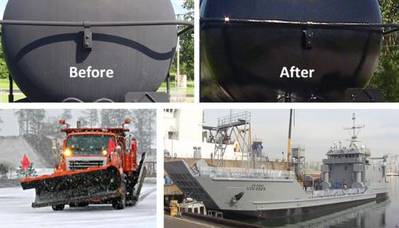Nanovere Launches New Industrial Nanocoating
Advancements in nanotechnology currently offer organizations with cargo ships, fleet vehicles, trains and industrial equipment a long-term alternate to conventional paints. Nanovere Technologies introduces Nano-Clear for Industrial Applications, designed to dramatically improve corrosion resistance, abrasion resistance and prevent the underlying paint from UV degradation. According to the manufacturer, Nano-Clear is the only industrial coating in the marketplace to restore, enhance and preserve newly painted or highly oxidized paint surfaces by 10 years.
Conventional one and two-component paint systems including epoxies provide good initial corrosion and abrasion resistance, but fall short in long-term UV resistance and weathering. Conventional paints begin to degrade over time due to sun damage, abrasion or chemical attack. UV rays break-down the molecular bonds of the paints polymer network, causing surface chalking, decreased abrasion resistance and discoloration, leading to corrosion.
The U.S. Army uses two-component conventional epoxy top-coatings on the decks of Landing Craft Utility - Ships to improve abrasion resistance from tanks driving aboard and to prevent corrosion. This epoxy system begins to yellow within three weeks, oxidize and corrode within six months at sea. And the Michigan Department of Transportation, for example, has to recoat its fleet of snow-plow trucks every few years due to corrosion issues from salt.
Nano-Clear penetrates deep into the smallest pores of paint, enhancing the underlying color, improving gloss, increasing surface hardness, and dramatically extending UV resistance (99% gloss retention). Nano-Clear protects the underlying paint from scratching, corrosion, chemicals and UV degradation, while reducing surface cleaning by 50%.
Nano-Clear is manufactured using proprietary 3D nanostructured polymers, which the manufacturer claims provides higher crosslink density over any conventional coating system today. Crosslink density is defined as the concentration of chemical bonds within a polymer. Higher concentrations of chemical bonds within a polymer improve physical properties. Conversely, lower concentrations of chemical bonds within a polymer decrease physical properties. Nano-Clear's molecular bonds are difficult to break-down from chemical attack, abrasion and UV rays. Nano-Clear is a one-component highly cross-linked polyurethane hybrid nanocoating system.











